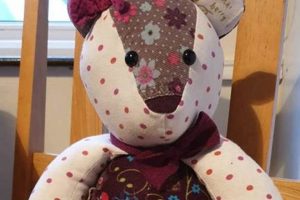Memory bears, crafted from repurposed garments of deceased family members or friends, offer a tangible and comforting connection to lost loved ones. These personalized keepsakes transform articles of clothing into cherished mementos, imbued with sentimental value. A shirt, a dress, or even a tie can be reimagined as a soft, huggable companion, providing solace and a tangible link to the past.
The enduring appeal of these handcrafted tributes lies in their ability to provide comfort during grief and bereavement. They offer a unique way to preserve memories and celebrate the life of someone special. Holding a bear made from a loved one’s clothing can evoke cherished memories, scents, and tactile sensations, fostering a sense of closeness and continuity. This practice also contributes to sustainability by repurposing existing materials, reducing textile waste and giving new life to beloved garments.
The following sections will delve deeper into the process of creating these meaningful keepsakes, exploring the materials, techniques, and emotional significance involved in their creation. Further discussion will address the therapeutic benefits, the stories behind individual bears, and the growing community of artisans dedicated to this craft.
Tips for Creating Memory Bears
Creating keepsake bears from the clothing of loved ones requires careful consideration and planning. These tips offer guidance for navigating the process respectfully and achieving optimal results.
Tip 1: Garment Selection: Choose garments that hold significant emotional value and are made of suitable fabrics. Sturdy materials like wool, denim, or corduroy work well. Delicate fabrics like silk or lace might pose challenges.
Tip 2: Professional Assistance: Consider commissioning a professional seamstress or memory bear artist, particularly if sewing experience is limited or the garment is intricate. Experienced artisans possess the skills and knowledge to handle delicate materials and create well-crafted keepsakes.
Tip 3: Cleaning and Preparation: Clean the chosen garments gently before starting the project. Air drying is recommended to prevent shrinkage or damage. Ironing may be necessary to ensure smooth, workable fabric.
Tip 4: Pattern Selection: Select a bear pattern appropriate for the available fabric and skill level. Simple patterns are recommended for beginners, while experienced sewers can explore more complex designs.
Tip 5: Incorporating Special Details: Personalize the bear with meaningful embellishments. Buttons, embroidery, or small patches from other garments can add sentimental touches.
Tip 6: Preservation: Once completed, store the memory bear in a clean, dry environment away from direct sunlight or extreme temperatures to preserve its condition and prevent fading.
Tip 7: Photographing the Process: Documenting the creation process can create a lasting record of the transformation. These photographs can become cherished memories in themselves.
By following these guidelines, individuals can ensure the creation of a lasting and meaningful tribute to their loved ones, preserving precious memories in a tangible form.
The creation of memory bears offers a unique way to honor and remember those who have passed. The following section will explore the emotional impact of these cherished keepsakes and the comfort they provide.
1. Comforting Keepsakes
Comforting keepsakes play a crucial role in the grieving process, offering tangible connections to lost loved ones. Memory bears, crafted from the clothing of the deceased, represent a powerful example of such keepsakes. The act of transforming familiar garments into a soft, huggable form imbues the object with deep emotional significance. The tactile experience of holding a memory bear can evoke memories associated with the wearer of the original clothing, offering a sense of closeness and comfort during a time of loss. This connection can be particularly poignant for children experiencing grief, providing a tangible representation of their loved one.
The inherent value of comforting keepsakes lies in their ability to facilitate remembrance and healing. A memory bear serves as a physical embodiment of cherished memories, enabling individuals to maintain a connection with the deceased. The scent of familiar fabric, the texture of a well-worn shirt, can trigger powerful emotional responses, offering solace and a sense of continuity. These tangible reminders can become integral parts of the grieving process, helping individuals navigate their loss and maintain a connection to their loved one’s memory. For instance, a child might sleep with a bear made from their grandparent’s pajamas, finding comfort in the familiar scent and texture.
The creation and use of comforting keepsakes like memory bears represent a healthy and constructive way to cope with grief. These objects provide more than just sentimental value; they offer a tangible link to the past, facilitating remembrance and emotional healing. While the pain of loss remains, these keepsakes can offer solace and a sense of continued connection, supporting individuals as they navigate their grief journey. Understanding the significance of comforting keepsakes underscores the importance of these objects in the grieving process and highlights the unique role memory bears play in providing comfort and support during times of loss.
2. Tangible Memories
Grief often manifests as a yearning for connection with the deceased. Tangible memories offer a powerful means of bridging this gap, providing physical reminders of shared experiences and loved ones. Memory bears, constructed from the clothing of someone who has passed, epitomize this concept. They transform garments imbued with personal historya favorite shirt, a worn sweaterinto a lasting embodiment of the individual. This transformation allows abstract memories to take on a concrete form, offering comfort and solace through the sense of touch. A worn patch on the shirt, a familiar button, becomes a focal point for reminiscence, triggering associated memories and emotions.
The power of these tangible memories lies in their ability to evoke sensory experiences. The feel of the fabric, perhaps softened with age and wear, can recall the feeling of a loved one’s embrace. The scent of the garment, often lingering faintly even after being repurposed, can transport one back to a specific time and place. These sensory cues provide a powerful and immediate connection to the deceased, fostering a sense of continued presence. For example, a child who has lost a parent might find comfort in clutching a bear made from their parent’s favorite robe, the familiar texture and faint scent offering a tangible link to their lost loved one.
The creation and preservation of tangible memories, exemplified by memory bears, serve a vital function in the grieving process. They provide a concrete link to the abstract realm of memory, offering comfort, solace, and a sense of continued connection. These objects become more than mere keepsakes; they become vessels of memory, facilitating remembrance and aiding in the complex journey of grief. Recognizing the importance of tangible memories emphasizes the profound impact these objects can have on those coping with loss and highlights the enduring power of memory in navigating grief.
3. Repurposed Garments
Repurposing garments represents a key element in the creation of memory bears. These cherished keepsakes derive their significance from the transformation of clothing imbued with personal history. A worn shirt, a favorite dress, or even a familiar tie, all carry the essence of the individual who wore them. By repurposing these garments, their inherent value is amplified, transitioning from everyday attire to tangible embodiments of memory and love. This act of transformation imbues the resulting keepsake with deep emotional resonance, offering comfort and solace to those grieving the loss of a loved one. For instance, a father’s flannel shirt might be repurposed into a bear for a child, providing a comforting physical reminder of his presence.
The act of repurposing offers a sustainable approach to preserving memories. Rather than discarding garments laden with sentimental value, they are given new life. This sustainable practice aligns with a growing awareness of environmental responsibility, reducing textile waste while simultaneously creating objects of profound personal significance. Furthermore, the process of repurposing can be a therapeutic experience for those involved. The careful selection of garments, the thoughtful planning of the design, and the meticulous stitching can become a meditative act of remembrance, allowing individuals to actively engage with their grief in a constructive and meaningful way. Consider a family creating multiple bears from a loved one’s quilt, each family member participating in the process and receiving a unique keepsake.
Repurposing garments for the creation of memory bears offers a unique intersection of sustainability, emotional healing, and tangible remembrance. This practice allows loved ones to preserve cherished memories in a physical form, offering comfort and solace during times of grief. The transformation of clothing into keepsakes embodies the enduring power of memory and the importance of finding meaningful ways to honor and remember those who have passed. The resulting bears are not merely toys; they are tangible representations of love, loss, and the enduring power of human connection.
4. Personalized Tributes
Personalized tributes offer a powerful means of honoring the unique lives of deceased loved ones. Memory bears crafted from loved ones’ clothing exemplify this concept, transforming personal garments into cherished keepsakes. The inherent personalization stems from the source material itself: clothing imbued with the individual’s essence, from a favorite worn shirt to a treasured formal dress. This connection transforms the keepsake from a generic item into a deeply personal tribute, echoing the individual’s personality, style, and memories. A musician’s bandana fashioned into a bear’s scarf, a grandmother’s floral dress becoming the bear’s main body, these details elevate the tribute beyond a simple stuffed animal.
The act of personalization extends beyond the mere utilization of clothing. Embellishments, such as buttons, patches, or embroidered initials, further enhance the tribute’s personal significance. Adding a small charm representing a loved one’s hobby, or embroidering a significant date onto the bear’s paw, amplifies the emotional resonance. These carefully chosen details transform the memory bear into a unique and powerful symbol of remembrance, reflecting the individual’s passions, experiences, and personality. Consider a bear made from a loved one’s military uniform, adorned with their rank insignia and a small embroidered American flag, transforming the keepsake into a poignant tribute to their service.
The creation of personalized tributes, such as memory bears made from clothing, provides a tangible connection to the deceased. These keepsakes offer comfort and solace during grief, serving as a physical embodiment of cherished memories. The act of transforming personal belongings into a lasting tribute acknowledges the individual’s unique life and legacy, offering a powerful means of remembrance and healing. The ability to personalize these tributes further amplifies their significance, ensuring each keepsake accurately reflects the essence of the loved one being honored. This profound connection between personalized tributes and tangible memories underscores the importance of these keepsakes in navigating the grieving process.
5. Lasting Connections
Lasting connections to deceased loved ones often prove challenging to maintain, particularly in the face of profound grief. Memory bears crafted from the clothing of the departed offer a unique solution, forging a tangible link to the past. These keepsakes transcend the realm of ordinary objects; they become vessels of memory, imbued with the essence of the individual. The familiar texture of a well-worn shirt, the faint scent of a favorite sweater, these sensory details evoke powerful memories, fostering a sense of continued connection. A child clutching a bear made from their grandmother’s apron, a widow holding a bear fashioned from her husband’s favorite tie, these examples illustrate the profound impact of these tangible connections. The memory bear becomes a conduit to the past, facilitating remembrance and mitigating the pain of separation.
The significance of these lasting connections lies in their capacity to facilitate the grieving process. While the pain of loss remains, the tangible presence of a memory bear offers comfort and solace. It serves as a physical embodiment of cherished memories, allowing individuals to actively engage with their grief in a healthy and constructive manner. The act of holding, touching, and interacting with the bear can provide a sense of closeness to the deceased, mitigating feelings of isolation and despair. Furthermore, these keepsakes can foster intergenerational connections. A grandparent’s memory, preserved in the form of a bear, can be passed down through generations, fostering a sense of familial history and continuity. This tangible link to the past can strengthen family bonds and provide a sense of shared heritage.
The creation of lasting connections through memory bears highlights the profound impact of tangible objects in navigating grief. These keepsakes offer more than mere sentimental value; they provide a concrete link to the abstract realm of memory, offering solace and facilitating the complex journey of mourning. The ability to maintain a connection to deceased loved ones, even in a tangible form, can significantly impact the healing process, providing comfort, support, and a sense of continued presence amidst absence. The enduring power of these connections underscores the importance of finding meaningful ways to honor and remember those who have passed, ensuring their legacy lives on through cherished memories and tangible keepsakes.
Frequently Asked Questions
This section addresses common inquiries regarding memory bears crafted from the clothing of deceased loved ones. Understanding these aspects can assist individuals considering commissioning or creating such keepsakes.
Question 1: What types of clothing are suitable for creating memory bears?
Sturdy fabrics like cotton, wool, denim, or corduroy are ideal. Delicate materials like silk or lace can be more challenging but are often incorporated as accents. Consulting with a professional is recommended for delicate fabrics.
Question 2: What is the typical cost of a professionally made memory bear?
Prices vary depending on the artist, the complexity of the design, and the size of the bear. Researching various artists and requesting quotes is advisable.
Question 3: How long does the creation process typically take?
The timeframe varies based on the artist’s workload and the complexity of the project. Communication with the chosen artist is crucial for establishing realistic expectations.
Question 4: Can specific elements of the clothing be incorporated into the bear’s design?
Many artists specialize in incorporating specific elements, such as pockets, buttons, or collars, into the bear’s design. Clear communication regarding desired features is essential during the consultation process.
Question 5: What are the care instructions for a memory bear?
Gentle spot cleaning is typically recommended. Storing the bear in a cool, dry place away from direct sunlight will help preserve its condition and prevent fading.
Question 6: Are memory bears suitable for all ages?
While often given to children, memory bears offer comfort and solace to individuals of all ages grieving the loss of a loved one.
Careful consideration of these frequently asked questions can provide valuable insights into the process and significance of memory bears. These keepsakes offer a unique and tangible way to honor and remember loved ones, providing comfort and solace during times of grief.
The subsequent section will showcase examples of memory bears crafted from various garments, demonstrating the versatility and artistry of this unique craft.
Teddy Bears Made Out of Loved Ones Clothing
Memory bears offer a unique approach to preserving the memory of deceased loved ones. This exploration has highlighted their significance as tangible representations of remembrance, comfort, and enduring connection. From the repurposing of cherished garments to the personalization of individual tributes, these keepsakes embody a powerful intersection of emotional healing and tangible commemoration. The diverse benefits, encompassing comfort during grief, sustainable practices, and the facilitation of lasting connections, underscore the profound impact of these handcrafted creations.
The enduring power of memory bears lies in their ability to transform grief into tangible remembrance. These keepsakes offer a path toward healing and a means of preserving the essence of those who have passed. Consideration of the thoughtful creation and enduring significance of these keepsakes may offer solace and a tangible link to cherished memories for those navigating loss.







